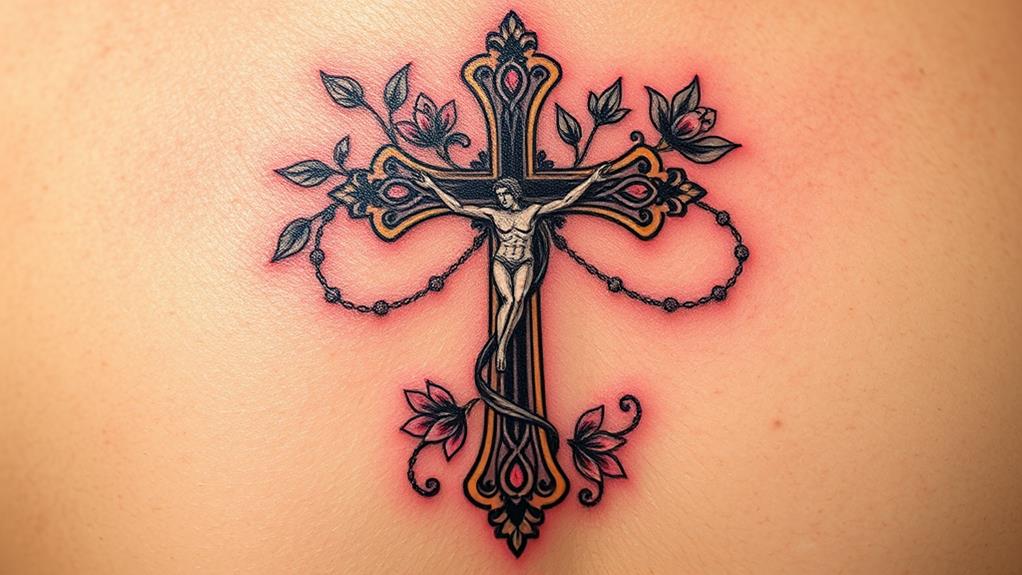I love how rosary cross tattoos beautifully blend faith with artistic designs. Each piece tells a personal story, showcasing spirituality through intricate patterns and vibrant colors. The cross symbolizes Christ's sacrifice, while the beads serve as reminders of prayer and devotion. I've seen styles ranging from traditional crucifixes to modern interpretations featuring floral elements and geometric shapes. Placement options are versatile, whether on the wrist for subtlety or the forearm for a bold statement. Personalizing the design can truly elevate its meaning, making it a unique piece reflecting my journey. There's so much more to explore in this art form!
History of Rosary Tattoos
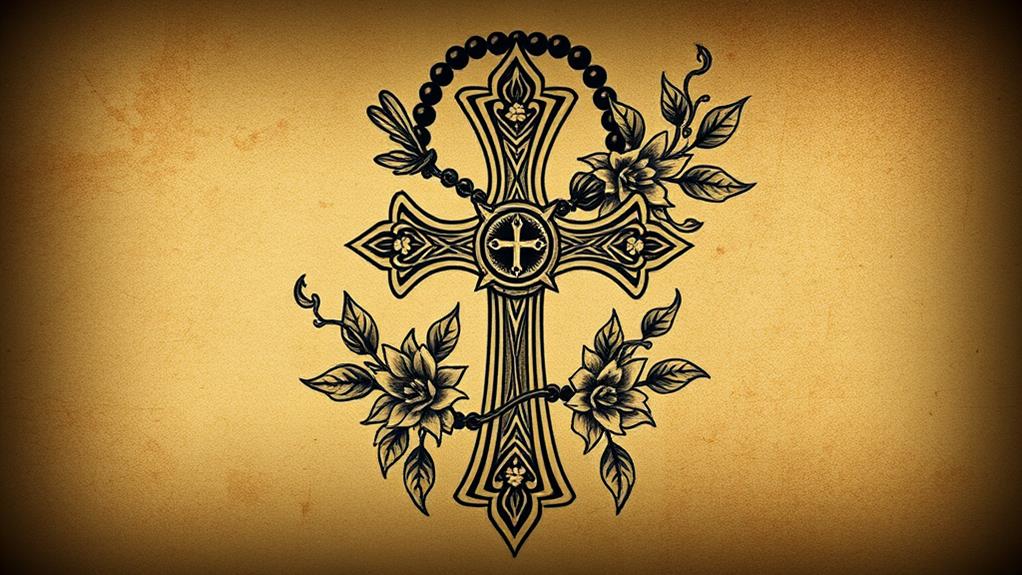
The history of rosary tattoos intertwines deeply with spirituality and personal expression, reflecting a journey of faith that many choose to share on their skin.
I find it fascinating how this art form evolved from traditional rosaries, which served as physical reminders of prayer and devotion, into a permanent symbol etched onto the body.
The practice of tattooing religious imagery dates back centuries, with early Christians using ink as a form of spiritual commitment.
As I explore this history, I see how cultural influences shaped the designs.
In Latin America, for instance, rosary tattoos often incorporate vibrant colors and intricate patterns, showcasing the blend of indigenous artistry and Catholicism.
The tattoos became a way for individuals to publicly display their beliefs, especially in communities where faith plays a central role in daily life.
Moreover, rosary tattoos serve as a personal narrative, allowing wearers to express their unique experiences with spirituality.
Each inked bead and cross tells a story, linking the individual to their heritage and faith.
This rich tapestry of history makes rosary tattoos not just body art, but a profound declaration to one's spiritual journey.
Symbolism of the Rosary Cross
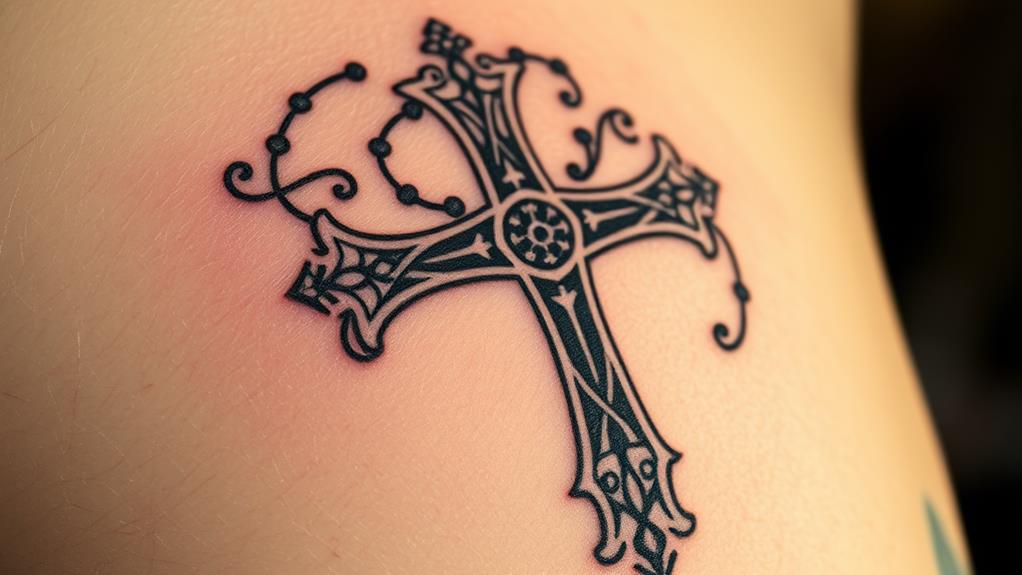
When I explore the symbolism of the rosary cross, I uncover layers of historical significance intertwined with deep spiritual meanings.
Each tattoo style I encounter reflects not only artistic interpretations but also a personal connection to faith and devotion.
It's fascinating how these designs transform a simple ink mark into a profound statement of belief and identity.
Historical Significance of Rosary
Throughout centuries, the rosary has woven itself into the fabric of Christian spirituality, serving as a powerful symbol of faith and devotion.
Its historical roots trace back to the early Middle Ages, evolving from a simple prayer tool into a cherished ritual for millions. I find it fascinating how the rosary initially emerged as a way for the faithful to keep track of prayers, often using knotted ropes or beads.
By the 16th century, the rosary's form solidified, connecting the Hail Marys and Our Fathers with the Mysteries of Christ's life—each bead representing a step in a profound spiritual journey.
The cross at the end symbolizes not just the crucifixion of Jesus but also the promise of salvation, acting as a bridge between divine grace and human experience.
As I explore the significance of the rosary, I appreciate its role in fostering community and individual reflection.
It's not merely a tool for prayer but a tapestry of history, tradition, and artistry, deeply interwoven with the lives of those who embrace it.
Each rosary tells a story, a legacy to an enduring faith that transcends time and space.
Spiritual Meaning Behind Tattoos
As I reflect on the profound symbolism of the rosary, it's clear that the rosary cross tattoo embodies a deep spiritual connection for many individuals.
Each element of the tattoo carries significant meaning, representing faith, protection, and a reminder of one's spiritual journey.
The cross itself symbolizes Christ's sacrifice, a powerful emblem of love and redemption.
When I see this tattoo, I'm reminded of the strength derived from faith and the comfort it brings, especially during life's trials.
Incorporating the rosary beads can enhance this symbolism, as they serve as a tactile reminder of prayer and meditation.
Each bead represents a moment of reflection, connecting the wearer to their beliefs and the divine.
For many, this tattoo isn't just an artistic choice; it's a declaration of their spiritual identity and a source of strength.
The rosary cross tattoo can also signify community, as it often resonates with shared beliefs among those who choose to wear it.
It becomes a conversation starter, linking individuals through their faith.
Ultimately, this tattoo serves as both a personal creed and a public expression of devotion, intertwining art with spirituality in a meaningful way.
Artistic Interpretations and Styles
Amid the diverse artistic interpretations of the rosary cross, each design captures a unique essence of faith and personal expression.
When I explore these tattoos, I'm often struck by the intricate details and the symbolism woven into each piece.
Some artists opt for a traditional approach, featuring the classic crucifix intertwined with beads, reflecting the sacredness of prayer. Others embrace a more modern aesthetic, incorporating elements like floral motifs or geometric shapes, which offer a fresh perspective on this timeless symbol.
I've seen designs that play with negative space, where the cross emerges from the void, emphasizing the idea of faith rising from darkness.
Then there are those that blend vibrant colors, infusing energy and life into the rosary, making it not just a symbol of devotion but also a celebration of individual artistry.
Every tattoo tells a story, and the rosary cross is no exception.
It's a canvas for personal beliefs, with each style resonating differently with its wearer.
Ultimately, these artistic interpretations serve as a powerful reminder that faith can be expressed in countless creative ways, each just as meaningful as the last.
Artistic Styles and Interpretations
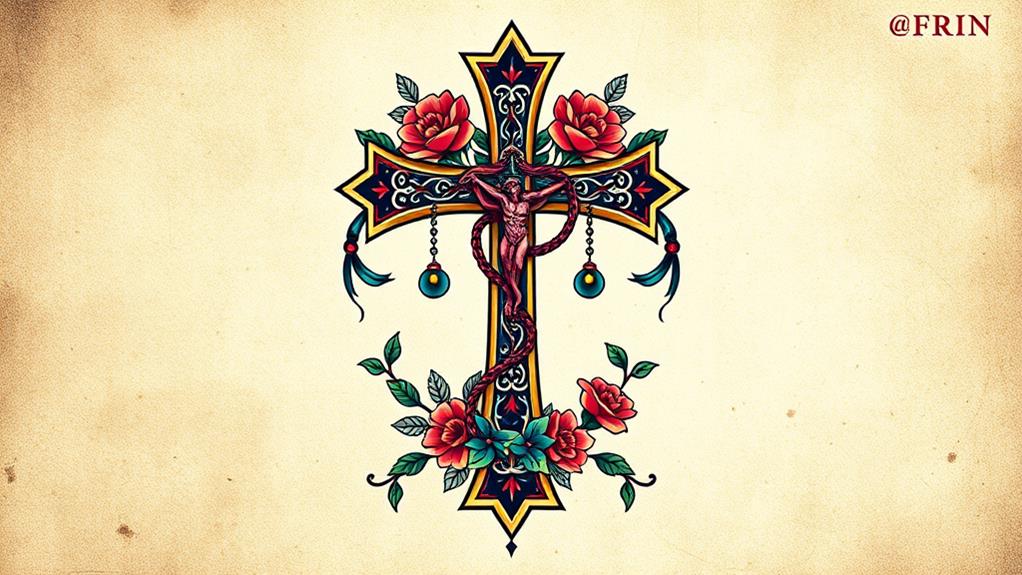
The beauty of rosary cross tattoos lies in their diverse artistic styles and interpretations that reflect personal beliefs and cultural backgrounds.
I've seen designs ranging from intricate Baroque patterns to minimalist lines, each telling its own unique story.
The traditional style often incorporates rich details, with ornate scrollwork and decorative elements that evoke a sense of reverence.
These designs can be striking, showcasing a masterful blend of spirituality and artistry.
On the other hand, I'm drawn to modern interpretations that strip away excess while maintaining the essence of the rosary cross.
These tattoos often feature bold lines and negative space, creating a contemporary look that resonates with younger generations.
Color plays a significant role too; I find vibrant hues can add a layer of depth, symbolizing various aspects of faith and life experiences.
Additionally, some artists incorporate elements like floral patterns or geometric shapes, adding a personal touch that signifies growth or transformation.
Each tattoo becomes a canvas, merging faith with individuality, and I believe that's what makes every rosary cross tattoo profoundly unique.
It's not just ink on skin; it's a meaningful expression of one's journey.
Placement Ideas for Tattoos
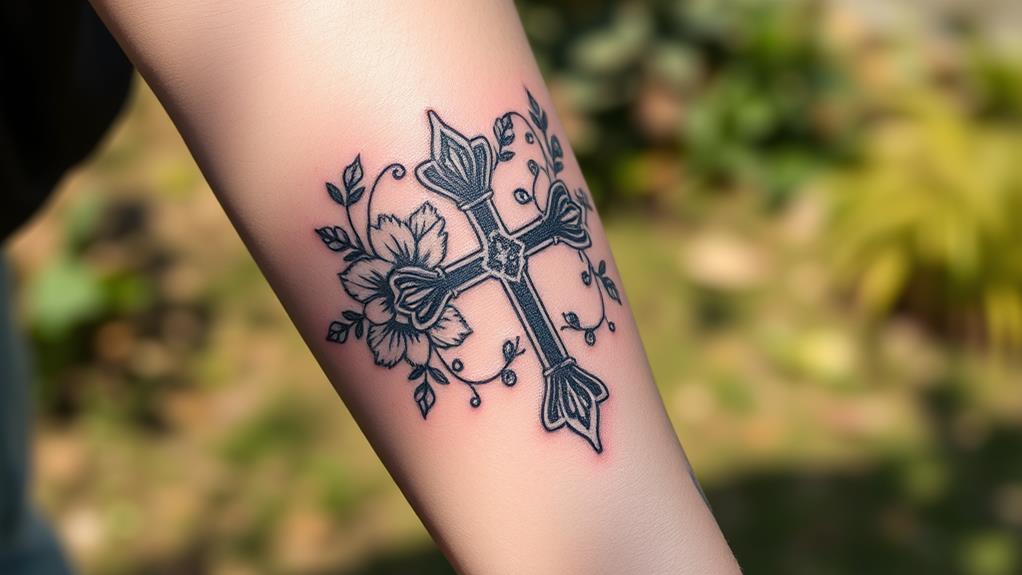
Choosing the right placement for a rosary cross tattoo can substantially enhance its meaning and impact.
When I first considered my tattoo, I realized that the location wouldn't only affect the design's visibility but also how it resonates with my personal journey.
Here are three compelling placement ideas that I found particularly meaningful:
- Inner Wrist: This area offers a subtle yet visible place to showcase your faith. Every time I glance at it, it serves as a reminder of my beliefs, making it a personal touchstone.
- Chest: Placing the tattoo over the heart symbolizes the deep connection between faith and emotion. This choice resonates with many who want to express their love for their spirituality, embodying a powerful message of devotion.
- Back Shoulder: This spot provides ample space for intricate designs and can be easily covered if needed. I appreciate how this placement can turn into a stunning focal point, especially during warmer months when I wear sleeveless tops.
Each placement carries its own significance, ensuring that the tattoo remains a reflection of my faith and artistic expression.
Personalizing Your Design
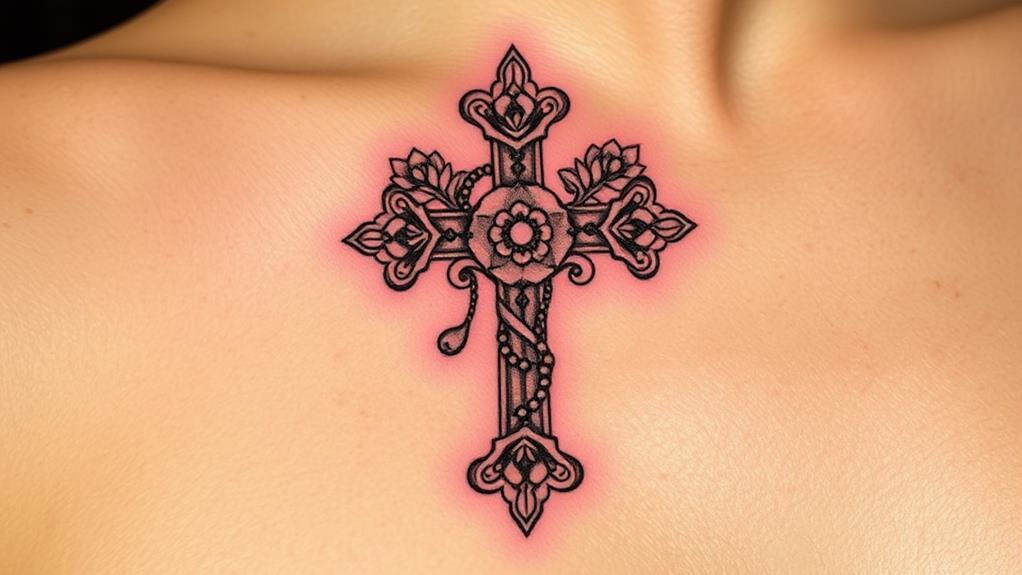
When I think about personalizing my rosary cross tattoo, I envision integrating symbolic elements that resonate deeply with my faith.
Choosing a color palette that reflects my personality adds another layer of meaning, making the design uniquely mine.
I also consider how placement can enhance the overall impact, turning my tattoo into a personal statement that tells my story.
Symbolic Elements Integration
While exploring the rich symbolism behind rosary cross tattoos, I found that integrating personal elements can elevate your design beyond mere aesthetics.
Each tattoo tells a story, and infusing it with symbols that resonate with your journey makes it uniquely yours.
Here's how I approached the integration:
- Incorporating Initials: I added initials of loved ones within the beadwork of the rosary. This small detail transforms the tattoo into a tribute, reminding me of their significance in my life.
- Choosing Significant Dates: By embedding a date on the cross, I memorialized an important event—perhaps a baptism or a moment of spiritual awakening. It's a powerful way to commemorate life's milestones.
- Including Nature Elements: Surrounding the cross with subtle floral designs, like roses or lilies, allows me to connect my faith with the beauty of creation. Each flower symbolizes different virtues, enhancing the tattoo's depth.
Color Palette Choices
As I pondered the color palette for my rosary cross tattoo, I realized that the hues I selected could profoundly influence its emotional impact.
I wanted to convey my faith while also reflecting my personal style. Bright colors like vibrant blues and reds evoke a sense of joy and passion, while softer pastels can impart a more serene and contemplative vibe.
I considered using black or gray for the cross itself, giving it a classic and timeless appearance.
These neutral tones would allow the more colorful beads of the rosary to stand out, creating a striking contrast. In my mind, deep greens could symbolize growth and renewal, while rich purples might represent spirituality and nobility.
Incorporating gold or silver accents added an element of elegance, catching the light and enhancing the overall design.
I even thought about watercolor techniques, where colors blend seamlessly, imbuing my tattoo with a sense of movement and life.
Ultimately, my color choices became a reflection of my journey—both in faith and artistry—making my rosary cross tattoo uniquely mine.
Each hue would tell a story, intertwining my beliefs and aesthetic into a beautiful masterpiece.
Placement Considerations
Choosing the right placement for my rosary cross tattoo was just as important as the design itself. I wanted to guarantee that it not only resonated with my faith but also complemented my body's contours.
Each location carries its own significance, so I considered a few key aspects:
- Visibility: I thought about how visible I wanted the tattoo to be. A placement on my forearm or wrist would be easily seen, making it a conversation starter about my faith.
- Personal Meaning: I reflected on areas that held personal significance. My shoulder felt right because it symbolizes strength, a perfect spot for a symbol of my faith.
- Size and Detail: The intricacy of my design influenced my choice. I realized that larger areas, like my back or chest, would allow for more detail and a more impactful visual presence.
Ultimately, the placement I chose became part of my personal story, a daily reminder of my beliefs, and a piece of art that I proudly wear.
Each glance at my tattoo reinforces my connection to my faith, making the placement as meaningful as the design itself.
Caring for Your Tattoo
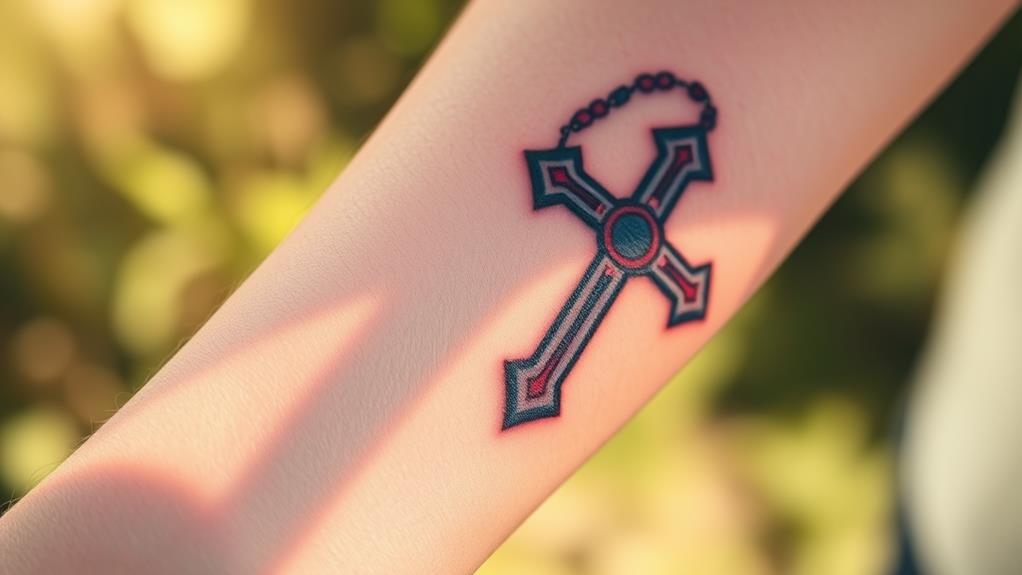
Proper care for your rosary cross tattoo is essential to certify it heals beautifully and remains vibrant for years to come.
Right after getting inked, I gently cleaned the area with lukewarm water and a mild, fragrance-free soap. Using my fingertips, I softly patted it dry with a clean towel, avoiding any rough fabrics that could irritate my skin.
In the following days, I applied a thin layer of fragrance-free moisturizer or a specialized tattoo aftercare ointment. I made sure not to slather it on; less is more when it comes to healing.
Keeping the tattoo covered with a breathable bandage for the first few hours helped protect it from bacteria.
I avoided soaking it in water—no baths or swimming for a few weeks. Instead, I took quick showers, keeping the tattoo out of direct water flow.
Sun exposure? I stayed clear of it, using sunscreen once it was fully healed to prevent fading.
Lastly, I resisted the urge to scratch or pick at any scabs, knowing that patience is key.
Caring for my tattoo hasn't only certified its beauty but also deepened my appreciation for the intricate artistry on my skin.
Inspiring Examples and Ideas
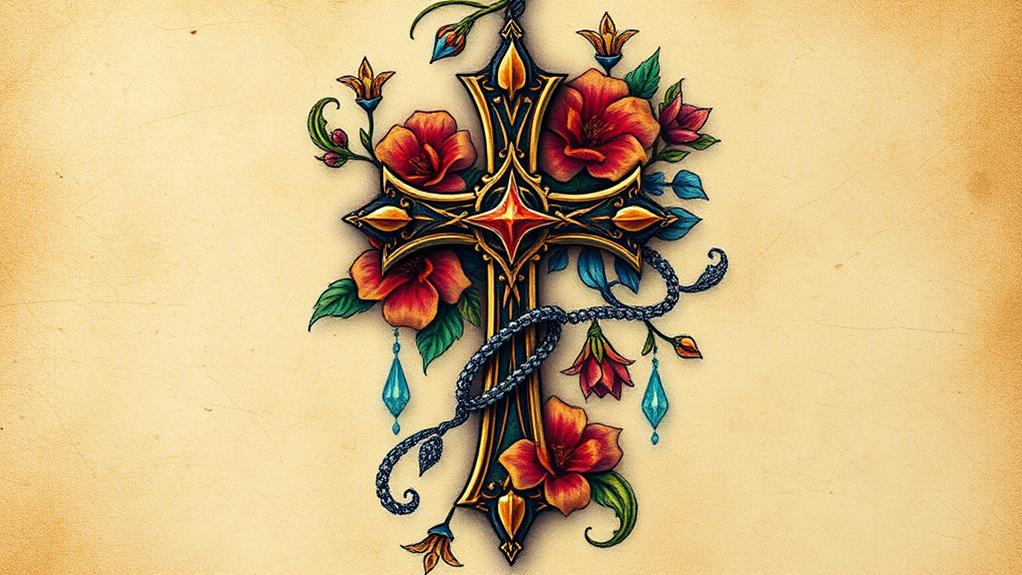
A rosary cross tattoo can serve as a powerful symbol of faith and personal expression, and there are countless ways to make it uniquely yours.
I've seen some truly inspiring designs that blend intricate artistry with spiritual significance.
Here are three ideas that really stood out to me:
1. Floral Accents: Incorporating roses or other meaningful flowers around the rosary adds a touch of nature and beauty.
The petals can symbolize purity and love, enhancing the overall message of faith.
2. Geometric Patterns: Some tattoos feature the rosary intertwined with geometric shapes.
This modern twist not only makes the design visually striking but also represents the connection between spirituality and the universe.
3. Personalized Text: Adding a meaningful quote or the names of loved ones along the rosary can make the tattoo even more personal.
It's a way to carry your faith—and those you cherish—with you at all times.
Each of these ideas sparks creativity while honoring the deep significance of the rosary cross.
Your tattoo should tell your story, combining artistry with the essence of your beliefs.
Frequently Asked Questions
Are Rosary Cross Tattoos Exclusively for Christians?
I believe rosary cross tattoos aren't exclusively for Christians. They can symbolize personal faith, spirituality, or artistic expression. Each design tells a unique story, allowing anyone to connect with its beauty and meaning, regardless of belief.
Can I Incorporate Other Symbols With My Rosary Tattoo?
Absolutely, I can blend other symbols into my rosary tattoo. Incorporating elements like flowers or meaningful initials adds personal depth, transforming it into a unique piece that reflects my journey while honoring my faith.
What Colors Are Popular for Rosary Cross Tattoos?
When I design my rosary cross tattoo, I love vibrant colors like deep blues, rich blacks, and radiant golds. These hues evoke a sense of spirituality and artistry, creating a meaningful visual impact that resonates deeply with me.
How Long Does It Typically Take to Get a Rosary Tattoo?
Getting a rosary tattoo usually takes about two to four hours, depending on the design's intricacy and size. I love the process; it's an intimate experience that allows me to express my faith artistically.
Are There Any Cultural Considerations for Getting a Rosary Tattoo?
When I consider getting a rosary tattoo, I think about the cultural significance. I respect the traditions and beliefs surrounding it, ensuring my design honors its meaning while expressing my personal connection to faith and art.
